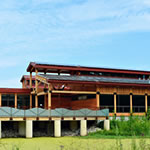In Naperville, Illinois, education and recreation converge on the same location where the East and West branches of the DuPage River meet: Knoch Knolls Park. A new, $6 million nature center celebrating water has been in the works for several years, and this fall, the Naperville Park District proudly opened the elaborate, interpretive building to residents and visitors. With the support of several grants totaling approximately $750,000 and the park district’s capital funds, the district constructed the 4,900-square-foot building, designed by Wight & Company, and permeable parking lot with the goal of educating the public about natural water systems. Park district director of planning Eric Shutes helps us boil the building down to three words that define its LEED Platinum design.
Tributaryˈtri-byə-ˌter-ē (noun)
A stream that flows to a larger stream or other body of water, or a person or nation that pays tribute in acknowledgment of subjugation. The building pays tribute to the two branches of the DuPage River that come together on its grounds. Visitors can view river wildlife in its river aquarium, rainwater in the building’s cistern that will keep its plantings alive, and the river bottom through a floor patterned off natural stones and fossils.
Elucidative i-ˈlü-sə-ˌdā-tiv (adj)
To make lucid or clear; throw light upon; explain. The building helps explain the workings and wildlife of the river while helping clean up the waste caused by its own construction. As the Naperville Park District’s first staffed nature center, the building educates visitors through interpretive signs inside and throughout the park.
Viable ˈvī-ə-bəl (adj)
Capable of living. The building includes a partial green roof and a living wall that uses plants to filter air coming into the building. It’s slated for LEED Platinum certification and generates its own energy from the photovoltaic array on its roof.

